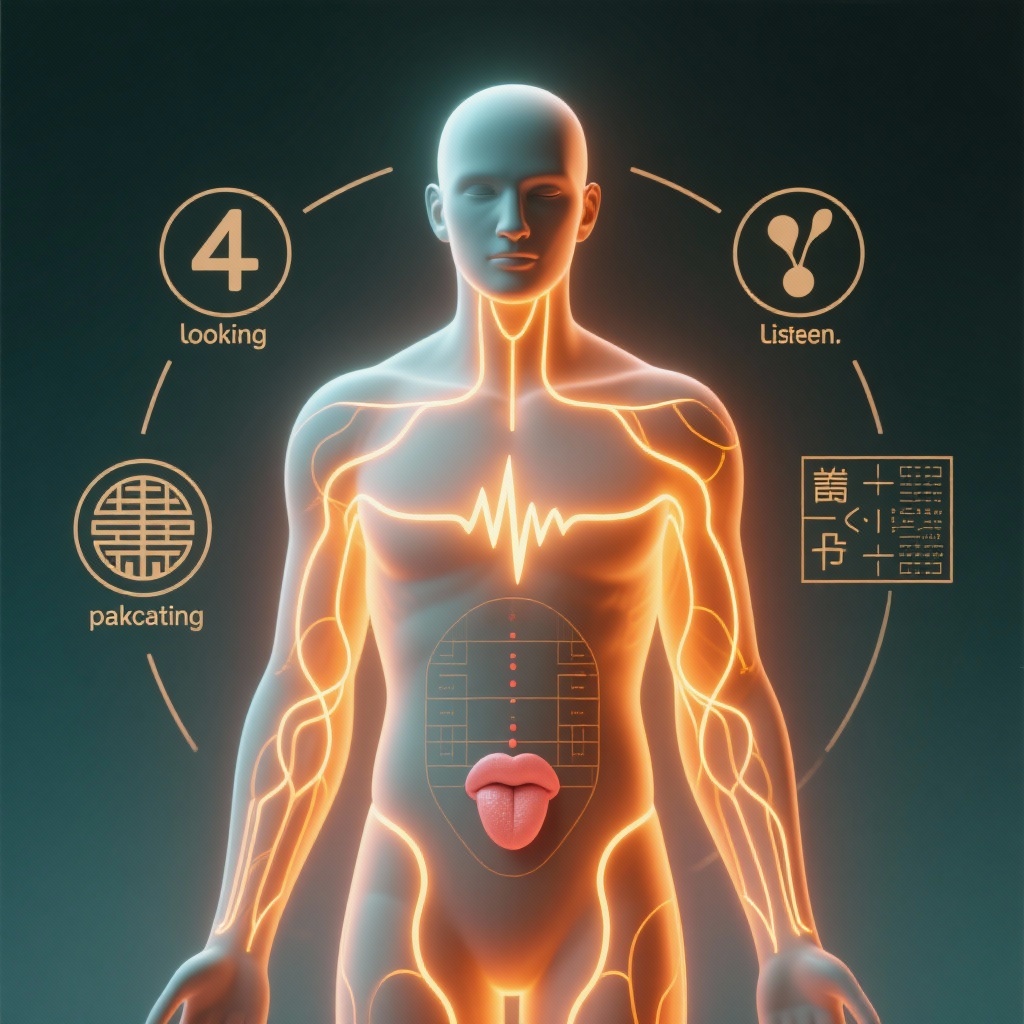Traditional Chinese Medicine (TCM) relies on “Four Diagnoses” as its core assessment method. These include observing, listening, asking, and palpating a patient. From a vital energy and essence perspective, each diagnostic method reveals different aspects of your body’s energy and nutrient status. Combining these insights gives us a comprehensive picture of your overall health. This holistic approach, fundamental to TCM Qi Blood Diagnosis, helps unlock your unique wellness profile. It’s like viewing a masterpiece from various angles to fully grasp its depth and beauty. For a deeper dive into TCM’s foundational concepts, visit TCM Basics.

Unlock Your Vitality: The Power of TCM Qi Blood Diagnosis through Observation
Observation, or “Wang Zhen,” involves carefully noting your spirit, complexion, body shape, and overall demeanor. Someone with abundant Qi and Blood often shows a bright, radiant complexion and vibrant eyes. They typically move with ease and agility. If your Qi is low, you might notice a pale face, general fatigue, or a weak speaking voice.
Discover Your True Glow: How Blood Nourishes Your Skin
On the other hand, Blood deficiency can manifest as a sallow or very pale complexion, along with dry hair and light-colored lips. When Qi and Blood become stagnant, it’s like a traffic jam in your body, leading to a dull complexion and purplish lips or tongue. Observing these facial and bodily changes offers immediate insights into the health of your internal organs and energy flow. This vital part of TCM Qi Blood Diagnosis guides practitioners toward accurate treatment strategies.
Attentively Listen: What Your Body’s Sounds Reveal
Listening, or “Wen Zhen,” involves both hearing your vocal qualities and noticing any particular body odors. Individuals with strong Qi usually speak loudly and clearly, with deep, steady breathing. Conversely, if your Qi is insufficient, your voice might be soft and weak, or you might experience shortness of breath and a tendency to sigh. This can also manifest as frequent coughing or wheezing.
Unlock Your Breath: Recognizing Energy Patterns
When Blood is deficient, people often speak hesitantly and feel tired easily, with their voice lacking sustained power. The pitch, strength, and clarity of these sounds help a practitioner evaluate the vitality of your Lung Qi and the robustness of your Heart Qi. These audible signals provide crucial clues for a thorough TCM Qi Blood Diagnosis.
Thoughtfully Inquire: Mapping Your Symptom Landscape
Asking questions, or “Wen Zhen,” is key to understanding your personal health journey and symptom experiences. Practitioners focus on your energy levels, appetite, sleep patterns, bowel movements, and, for women, menstrual cycles. Those with low Qi frequently report feeling extremely tired, a poor appetite, and an increased susceptibility to colds. A lack of Blood often causes restless sleep, vivid dreams, and a dull facial complexion.
Calm Your Nerves: Addressing Emotional Imbalances
Women might also notice light, pale menstrual flow. If your Qi is stagnant, you may experience chest tightness, frequent sighing, and significant mood swings. Blood stasis, on the other hand, typically presents as sharp, fixed pain that intensifies at night. Your tongue might also appear dark or purplish. These detailed responses are essential for a precise TCM Qi Blood Diagnosis.
Gently Palpate: Decoding Your Body’s Rhythmic Story
Palpation, or “Qie Zhen,” primarily involves pulse diagnosis, offering the most direct feel of your Qi and Blood circulation. A deficient Qi often results in a weak, thready pulse, indicating a lack of vital energy. When Blood is insufficient, the pulse might feel thin and rapid, or perhaps thin and choppy. If your Qi is stagnant, the pulse tends to be wiry and tight, reflecting tension.

Gauge Your Flow: Pulse as a Health Barometer
Blood stasis typically shows a choppy or knotted pulse, which is uneven and irregular. The speed, strength, and rhythm of your pulse directly mirror the heart’s ability to pump blood and the fullness of your blood vessels. This intricate pulse assessment is a cornerstone of effective TCM Qi Blood Diagnosis. To learn more about how food can support your Blood, explore Nourishing Blood Foods.
Thoughtfully Synthesize: Connecting All the Diagnostic Dots
Relying on just one diagnostic method can easily lead to an incomplete or inaccurate picture of health. A truly accurate TCM assessment demands the “Four Diagnoses” be thoroughly combined and analyzed. For example, a person might have a rosy complexion but a weak pulse, potentially indicating “False Heat” where underlying deficiency pushes Yang energy upwards.
Grasp the Full Picture: The Power of Combined Insights
Another example could be a loud voice paired with a pale tongue, which might signal a deeper Qi deficiency masked by a momentary burst of energy. By integrating and cross-referencing all these pieces of information, practitioners can identify primary and secondary imbalances. This comprehensive approach is essential for effective care. It allows a practitioner to create a targeted wellness strategy for you. “The physician considers the four examinations, thus he can discern the true condition of the patient.” (Huangdi Neijing, Suwen Chapter 19)
Empower Your Health: The Everyday Value of Qi Blood Insights
Mastering the “Four Diagnoses” from a Qi and Blood perspective enables a rapid understanding of your condition’s core nature. Every health challenge, whether acute or chronic, ultimately impacts how your Qi and Blood are produced, circulate, or consumed. Precise diagnostic assessments, including TCM Qi Blood Diagnosis, help tailor highly effective treatment plans. This approach addresses both symptoms and root causes, significantly enhancing overall clinical effectiveness.
Achieve Lasting Wellness: Beyond Symptom Relief
This insightful diagnostic framework is not just for treating illness; it also serves as a crucial guide for daily wellness and preventative care. For comprehensive understanding and actionable insights, consider exploring TCM Qi Blood Diagnosis through its emphasis on your body’s vital energy, blood circulation, nutrient transport, organ function, immune response, and overall vitality. This holistic perspective ensures sustainable health.
References:
(Huangdi Neijing, Suwen Chapter 19, “Treatise on the Comprehensive Diagnosis”)
Your 3-Second Self-Test & 30-Second Self-Rescue
Want a quick check of your Qi and Blood balance? Try this:
- If your face often looks pale or sallow, and you feel constantly tired even after rest → Immediately try this: Stand up, take five slow, deep breaths, and then gently tap your lower abdomen for 30 seconds to stimulate Qi flow.
- If your lips and nails are pale, and you frequently feel cold or lightheaded → Immediately try this: Rub your hands together until warm, then massage your ears for 30 seconds to promote blood circulation.
- If you frequently sigh, feel tense, and your mood swings easily → Immediately try this: Take 10 intentional, slow exhales, focusing on releasing tension from your chest.
Medical Disclaimer:This article is for educational use only and is not a substitute for professional medical advice.